| The Naked City | Jul 31 2022 |

Our recommendation is to never mess with the Mafia.
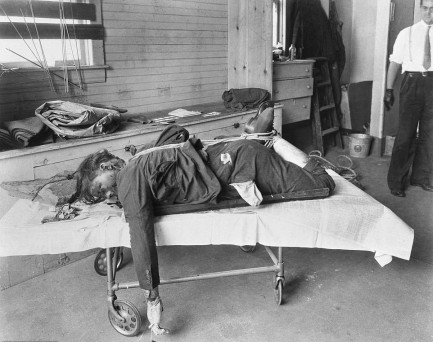
While we're on the subject of mobsters, this photo shows the grisly end of one Walter J. Sage. He ended up in this non-ideal condition after being stabbed more than thirty times, tied to a rock and a slot machine frame, and dumped in Swan Lake, located in Sullivan County, about eighty miles north of New York City. The slot machine aspect was ironic. Sage, a contract killer for the infamous Murder, Inc., also filled his hours by working for a mafia gang that ran a slot machine racket.
Unfortunately, he had a case of sticky fingers and his employers found out. Sage's colleagues took him for a ride north toward the Catskills, a trip they'd made many times. On this occasion they attacked him in the car, one man choking him and the other getting busy with an ice pick. Sage was no pushover. He managed to grab the car's steering wheel and run the vehicle into a ditch, but in the end he was overpowered, killed, hogtied, weighted, and dumped in the lake.
Some accounts claim he was in the water for two weeks, but a glance at the body disproves that. He was found four days later, today in 1937, which is when the photo was shot. It's amazing that a guy who was sent to kill people who had annoyed the mafia would himself annoy the mafia, but as the Dunning-Kruger effect teaches, some people suffer from a cognitive bias of illusory superiority. Or put another way, feeling smart doesn't mean you actually are. Sage could have benefitted from advice along those lines—but he probably wouldn't have listened anyway.
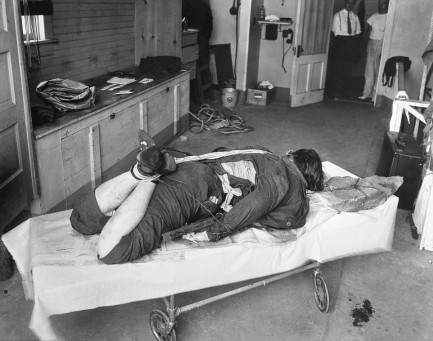
| The Naked City | May 25 2022 |

Mafia bigmouth's associates poke a few holes in his treasoning.
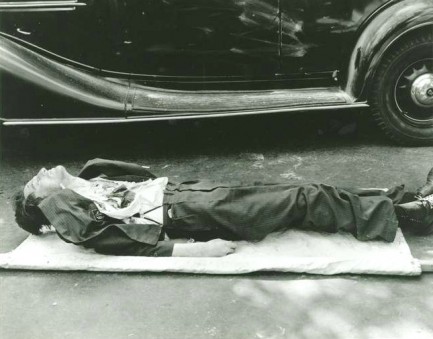
The peculiarly deflated figure you see above is George Rudnick, nicknamed Whitey, and with a handle like that you don't even have to see him dead to know he was a crime figure. He was also a stool pigeon, so one night his colleagues brought him along on a car theft caper, and after they boosted the wheels, they attacked him, choking him while stabbing him fifty or more times with an icepick. Some accounts say he was brutally hacked with a meat cleaver. We're inclined to think it was an icepick for the obvious reason that all his body parts seem intact, but in either case, you'd be deflated too after something like that. It happened today in 1937.
It took a few years, but two mafia footsoliders, Harry “Happy” Maione and Frank “The Dasher” Abbandando, both members of the infamous Murder, Inc., were arrested, indicted, and convicted for the killing. They appealed and were granted a new trial, but another guilty verdict sent the pair to a date with old sparky in Sing Sing Prison on February 19, 1942. If there's a lesson here, aside from don't hang with guys nicknamed Happy and Dasher unless they happen to work at the North Pole, it's probably to keep in mind how very, very picky the mafia is about employee loyalty.
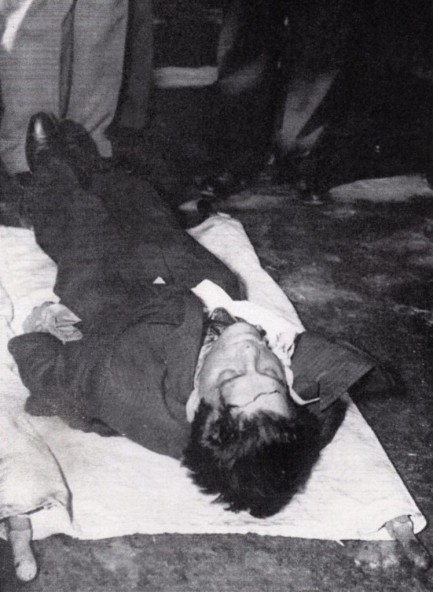

| Vintage Pulp | Apr 25 2022 |

Who can take a casino, walk in sight unseen, eliminate resistance, and collect up all the green? The candyleg. Oh, the candyleg can.
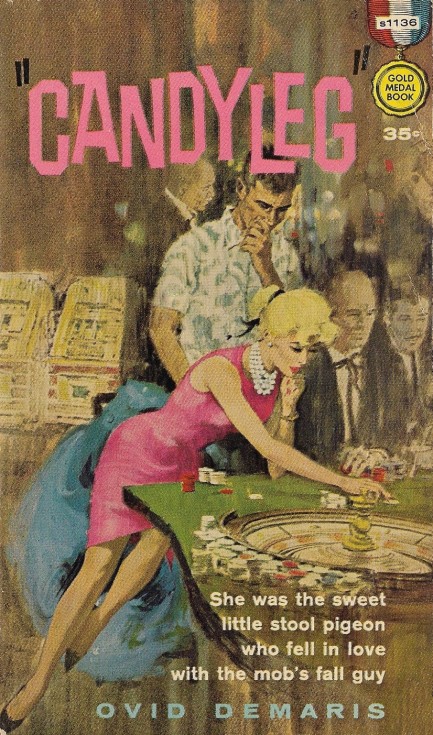
We just finished our second Ovid Demaris novel. The man could write, and his plot set-ups are compelling too. His 1961 mafia thriller Candyleg, also published as Machine Gun McCain, tells the story of McCain, an Alcatraz lifer, who's unexpectedly paroled and told it's so he can mastermind a Las Vegas casino robbery. Jack Falcon, the young and ambitious boss of the western states, wants the casino robbed because it's run by someone he dislikes. McCain is willing, plus he owes a debt for his release, but he soon learns that there are tricky crosscurrents.
Falcon has no doubt McCain can and will rob the casino, but knowing McCain is too independent to share information, Falcon commands his girlfriend Irene to keep McCain close—as in between the sheets—and report back everything going on. McCain, by the way, is Falcon's father. Why do they have different last names? Daddy issues. In any case, he's sending his girlfriend to lay his dad in order to pry info loose about the heist to relay back. It's precarious, family-wise, but high stakes require extraordinary efforts. Falcon needs the best for the heist, and his dad is the best.
Unfortunately, the controlling interests in the casino, who are all headquartered back east, catch vague wind of something related to their valuable and 100% legal investment, and one of their top bosses comes to town to impress upon Falcon that there can be no turbulence of any sort in Vegas—on pain of death. Absolutely, says Falcon, even as he's sweating the fact that McCain, who wants one big score followed by retirement in South America, has gone off-grid and is unreachable. Falcon is counting on Irene to keep in contact, but will she? She doesn't like her boyfriend nearly as much as she likes his dad.
We recommend this thriller. It has interesting characters, a lean but involving plot, good action, good movement, and a lot of moral ambiguity. In the crime fiction genre, Demaris is top notch. At least so far. We'll see if he can keep his streak going. Oh, and what's a candyleg, by the way? It doesn't have anything to do with Irene, though you'd think so reading the front cover blurb. It means a soft touch, and Irene uses it to describe McCain at one point. It's an interesting term, but she's wrong. McCain isn't soft. He's as tough as they come, and so is Demaris's fiction.
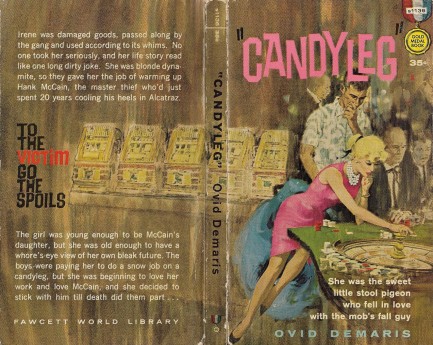
| The Naked City | Apr 15 2022 |

Mafia gunmen make a mess of Masseria.
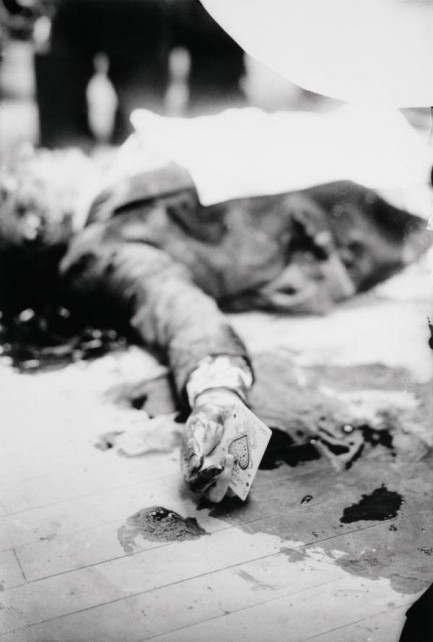
As artistic crime photos go, this shot of Giuseppe Masseria's corpse on the floor of Villa Tammaro, a seafood restaurant in Coney Island run by mobster Gerardo Scarpato, ranks highly. During the 1920s Masseria was the head of what later became known as the Genovese crime family. He was involved in a power struggle with another crime group run by Salvatore Maranzano, but at the same time there were tensions within Masseria's group because he was an old world, old school mobster who refused to work with non-Italians, and thus was leaving millions of dollars in criminal profits unclaimed. One of the young mafiosi in his clan who thought Masseria was an old-fashioned fool was Charles Luciano, aka Lucky Luciano. Tensions between Masseria and Luciano eventually devolved into open hostilities.
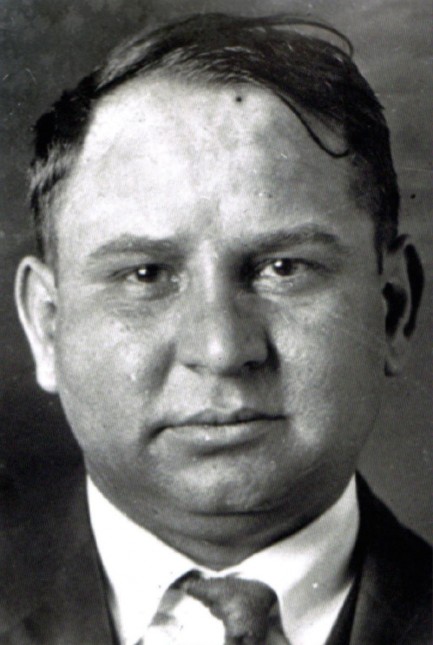 Masseria was a careful guy. He traveled in an armored sedan. But it's hard to take care of business from behind plate steel and bulletproof glass, so when Luciano invited him to a meeting at Villa Tammaro that promised to tamp down intra-clan tensions and refocus everyone on Salvatore Maranzano, the real enemy, he took the chance. He went to the restaurant, and the confab must have gone cordially up to a point, because Masseria, Luciano, and a couple of other men began playing cards. But at some point Luciano excused himself from the table and Masseria was gunned down by a fearsome foursome of Albert Anastasia, Vito Genovese, Joe Adonis, and Bugsy Siegel.
Masseria was a careful guy. He traveled in an armored sedan. But it's hard to take care of business from behind plate steel and bulletproof glass, so when Luciano invited him to a meeting at Villa Tammaro that promised to tamp down intra-clan tensions and refocus everyone on Salvatore Maranzano, the real enemy, he took the chance. He went to the restaurant, and the confab must have gone cordially up to a point, because Masseria, Luciano, and a couple of other men began playing cards. But at some point Luciano excused himself from the table and Masseria was gunned down by a fearsome foursome of Albert Anastasia, Vito Genovese, Joe Adonis, and Bugsy Siegel.There were a few other skirmishes for control, but essentially, taking Masseria off the board was the beginning of the end of hostilities. One more old school kingpin had to go—Maranzano, who had been communicating secretly with Luciano and had offered a deal of peace in exchange for Masseria's death. Months later Luciano took care of him too. With Masseria and Maranzano gone, the new mafia was restructured, modernized, and began working with non-Italians. Many accounts of Masseria's killing say he died at dinner, and while that's technically true, the autopsy showed that he had eaten nothing. Maybe he was afraid of being poisoned. Though cards had been scattered around the room in the chaos, the ace of spades was probably placed in his hand by a photographer. That was today in 1931.
| Vintage Pulp | Jan 23 2022 |

Damn it feels good to be a gangsta.
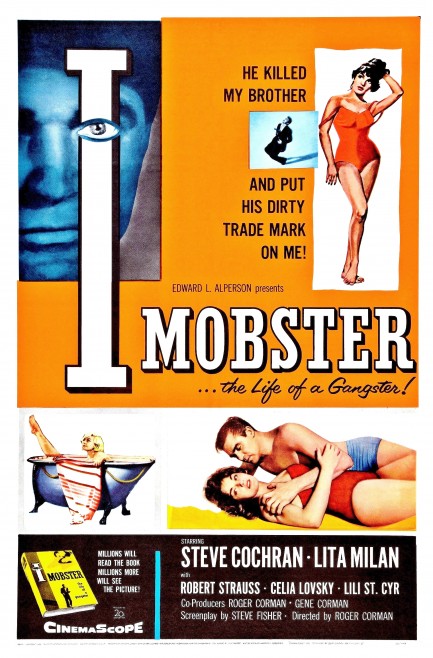
Above you see a U.S. promo poster for the crime drama I, Mobster, starring Steve Cochran in a rags-to-riches, innocence-to-corruption tale of a neighborhood kid who becomes a top man in the mob. The film was based on a 1951 novel of the same name published anonymously, but later identified as coming from the typewriter of Joseph Hilton Smyth, who also wrote Angels in the Gutter. The early plot driver is the mob's attempt to extort cash payments out of a powerful trade union. The plan is to offer services as “outside labor relations experts.” Cochran, as an ambitious footsoldier, expands the mob's vision, its areas of interest, and its profits. Pretty soon he's riding high, high, high. But it can't last. Of course not.
The film has the usual elements from this sub-genre: the round-the-way girl who offers redemption, the wailing mom who implores her son to go straight, the unimpressed father who eventually disowns him, the mob boss who's worried about his brash number two, and the ticking bomb—i.e. the seeds of destruction planted earlier. Here it's a little boy who knows Cochran killed a man. He grows up and becomes enfolded in the mob too, which places him in perfect position to blackmail Cochran. But Cochran is a tough cookie. It may take more than an ambitious twenty-something to bring him down, and it may be that the true seeds of destruction were planted earlier and elsewhere.
While the plot elements may be typical, the cast isn't. Cochran is a good, intense, underrated screen presence. Robert Strauss is perfect as Cochran's right hand man and steadying influence. The radiant Lili St. Cyr spices up the proceedings midway through with a burlesque routine. And the stunning Lita Milan is excellent as the good girl-turned-mob moll. In addition, the film is solidly directed. You often see I, Mobster, described as an early Roger Corman movie. Does a director's twentieth movie count as early? Corman knows what he's doing here. His road forked into the dark woods of schlock, but helming this production, with a low budget, he managed to squeeze out a solid b-mobster flick. There's nothing fresh in it, but with this cast freshness isn't needed. I, Mobster premiered today in 1959.
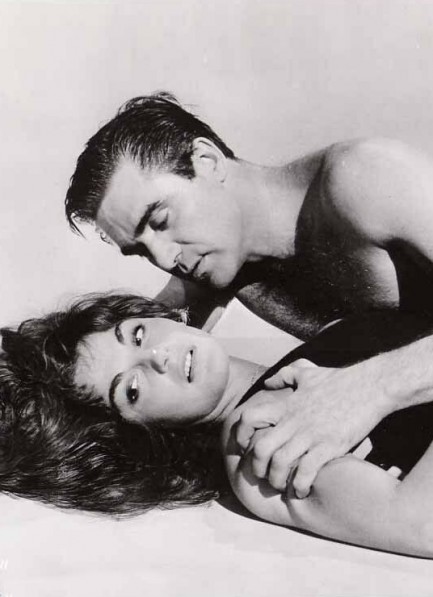 Don't play coy, baby. Would you rather be with a gangsta like me or some accountant from fuckin' donkeyville?
Don't play coy, baby. Would you rather be with a gangsta like me or some accountant from fuckin' donkeyville?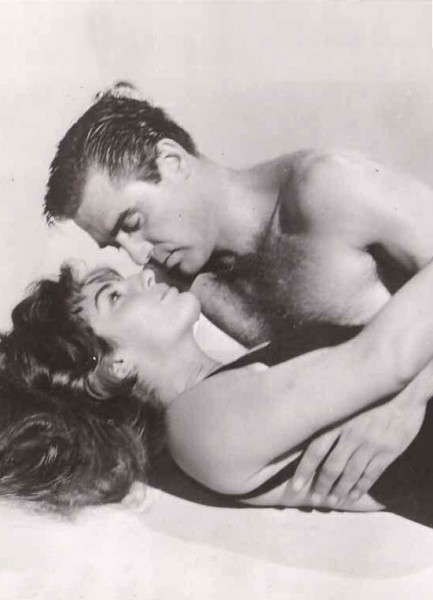 That's what I thought.
That's what I thought.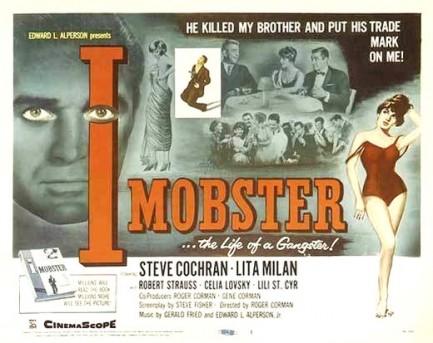
| Vintage Pulp | Dec 25 2021 |

T-Men shows Uncle Sam's money men hard at work keeping the greenback safe.
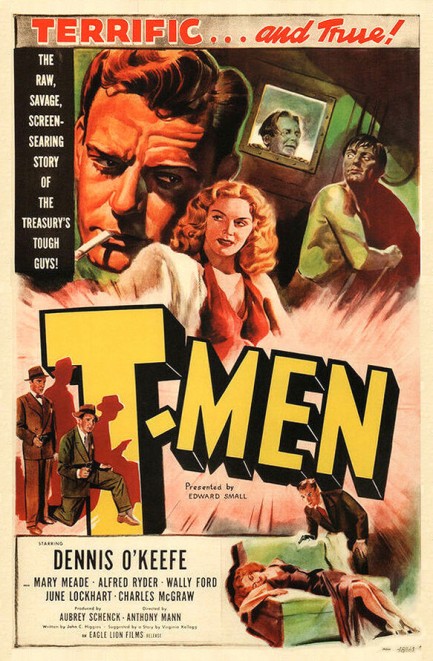
As you know by now, film noir derived from several sources, one of them being the hard-boiled pulp fiction of the 1930s and ’40s, such as the aforementioned Kiss Me, Deadly. As the cycle rolled onward, filmmakers routinely mined crime fiction for movies, and it became common for a book to be purchased for adaptation immediately after it was published. It was a heyday for crime authors. T-Men, for which you see a cool poster above and another at bottom, was not adapted from a novel. It came from a story idea by Virginia Kellogg, the unheralded brain behind films such as White Heat and Caged.
T-Men is the narrated tale of two treasury agents who infiltrate the Detroit mafia to stem a wave of counterfeiting. Dennis O'Keefe and Alfred Ryder play the duo of undercovers, looking sharp in their tailored suits, as they climb the mob chain of authority pretending to be in the possession of flawless counterfeiting plates they're willing to sell. The two take numerous risks to get close to the unknown head of the mob, and find themselves in hot water more than once. The question quickly becomes whether they can catch the crooks and stay alive.
You get excellent noir iconography here, courtesy of director Anthony Mann and cinematographer John Alton. In fact, though the movie is good anyway, the main reason to watch it is because it's a clinic in genre visuals, filled with beautiful shots where light and darkness intersect in sharp angles or blend like mist. The movie also makes good use of locations tailor-made for shadowplay—the steam room, the deserted street, the nighttime amusement park, the swank supper club, the gambling den, the photographer's darkroom, the industrial maze. If you didn't know better you'd think the filmmakers chose the locations first, then built a movie around them.
For those reasons, T-Men is a mandatory entry for film noir buffs, however it isn't quite perfect. Though there are many surprises, aspects of it related to survivability are predictable, and the narration nestles right up against pro-government propaganda, particularly toward the end. Generally, we think most vintage films could have done fine without narration, but here it's actually needed, so you'll have to ignore the filmmakers intent to teach the audience a lesson. That shouldn't be too hard—T-Men is an almost perfect noirscape, a place to get lost in darkness and enjoy the ride. It premiered in the U.S. today in 1947.

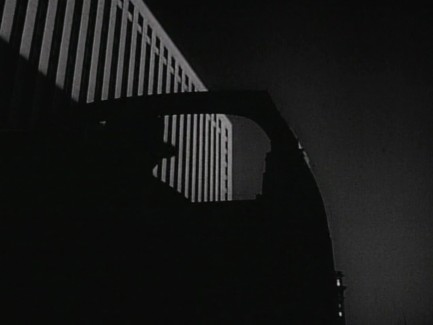
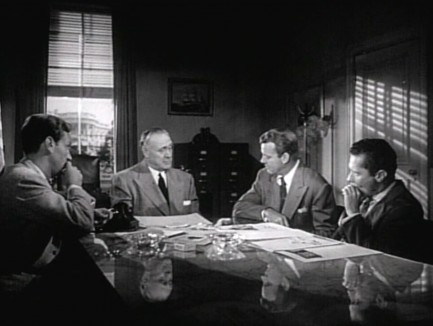
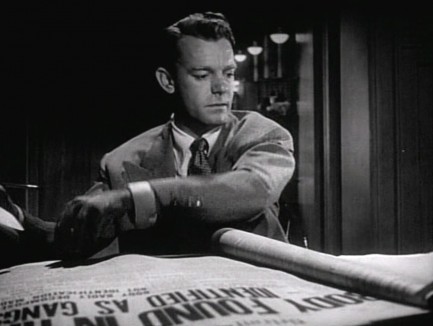
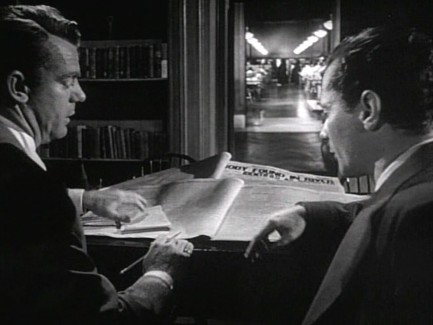
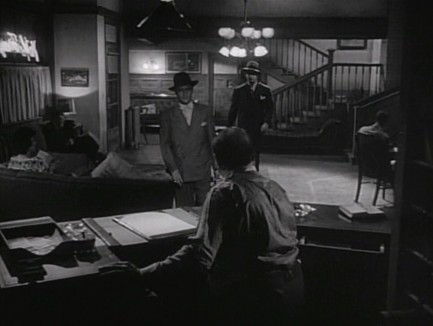
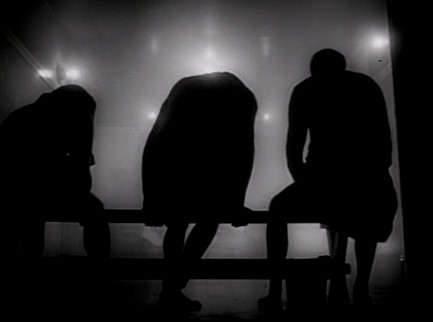
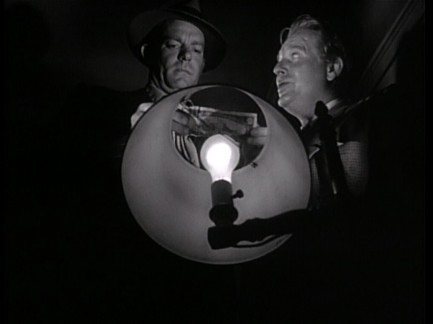
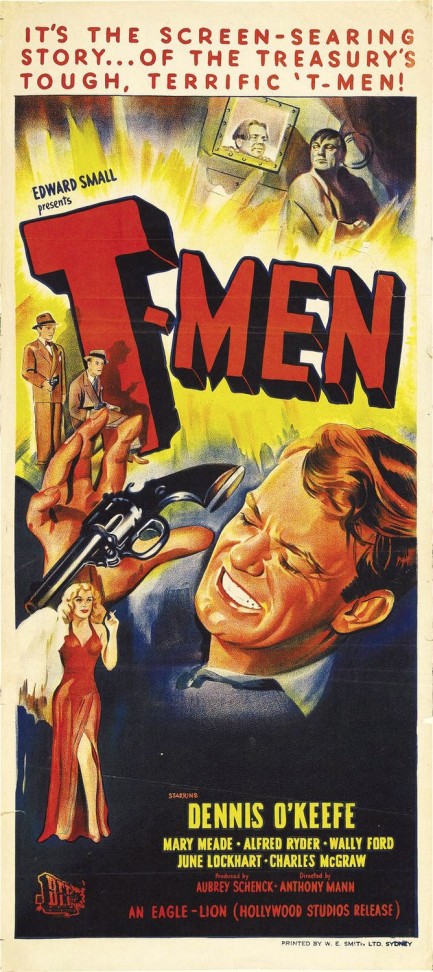
| Hollywoodland | Nov 29 2021 |

She was one of the most watched people in the world—onscreen and off.
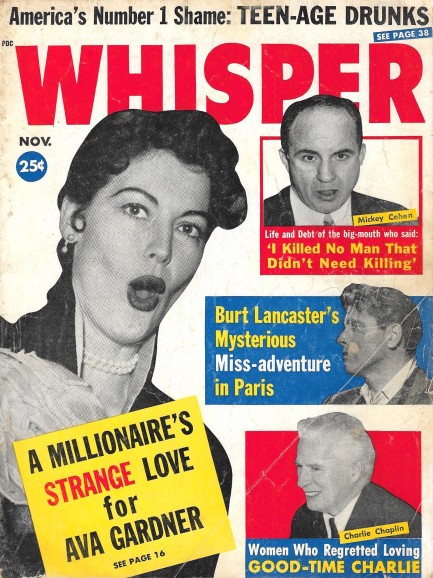
Whisper magazine, in this issue published this month in 1961, offers readers an interesting story about an unnamed millionaire's obsession with Ava Gardner. Apparently the millionaire hired people to follow Gardner around 24/7, all over the world, and report back to him, with this surveillance going on for years. The purpose? If he couldn't have her, he at least wanted to know what she was doing. Whisper focuses on a particular spy named Bill, the fourth of four spies employed by the millionaire, who Gardner came to be friends with and let live on her property, rather than have to sleep in his car night after night. Is this tale true? Maybe. Money buys a lot—including tolerance for bad behavior.
And speaking money, there's also a story on gangster Mickey Cohen, who counted among his consorts Liz Renay and Candy Barr, both of whom we've discussed, Renay here, and Barr here and here. Barr has also shown up in five magazines we've posted. The easiest way to see those is click her keywords and scroll. Cohen proves that no matter what people try to tell you, money is an aphrodisiac, because there's no way trolls like him could score beautiful dancers and models if it weren't for wealth. Take a look at the worst man in the world, and if he has money, he has a wife far more beautiful than makes sense.
Whisper goes on to talk about Burt Lancaster's and Charlie Chaplin's lovers, teen-age drunks, Soviet honeytraps, U.S. prisons, Jane Fonda's professional and family lives, and more. It was a Robert Harrison publication that morphed from a cheesecake magazine with painted pin-up covers into a gossip rag. That happened around 1954, when the original Whisper, launched in 1946, began going broke thanks to an inability to compete with girly magazine numero uno—Playboy. But there was plenty of room in the tabloid market and Harrison made Whisper a staple monthly on par with Confidential, his flagship publication. We'll have more from Whisper later, as always.
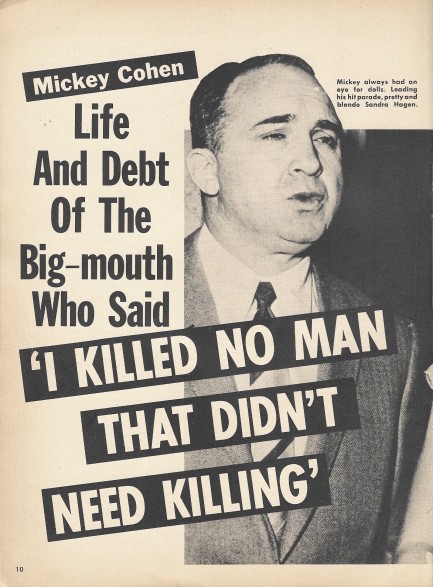
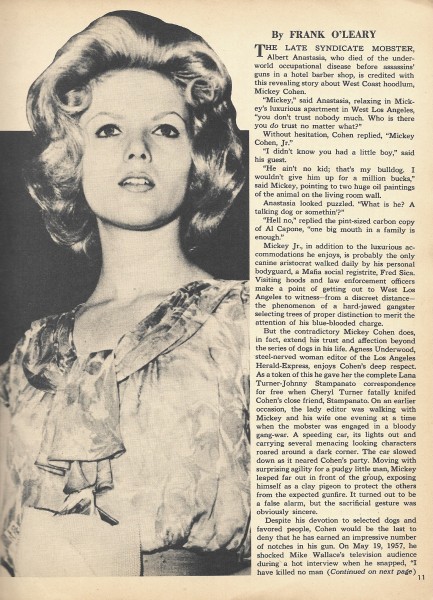
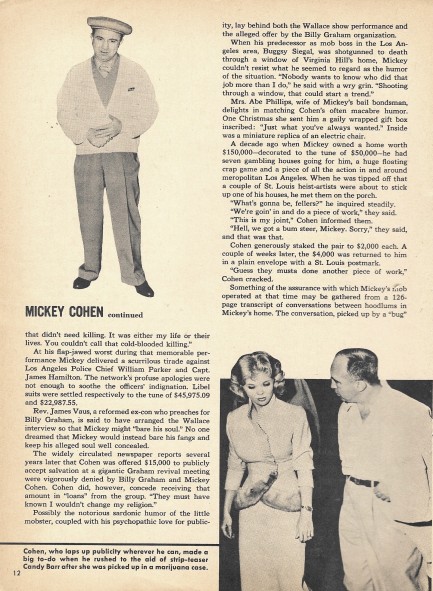
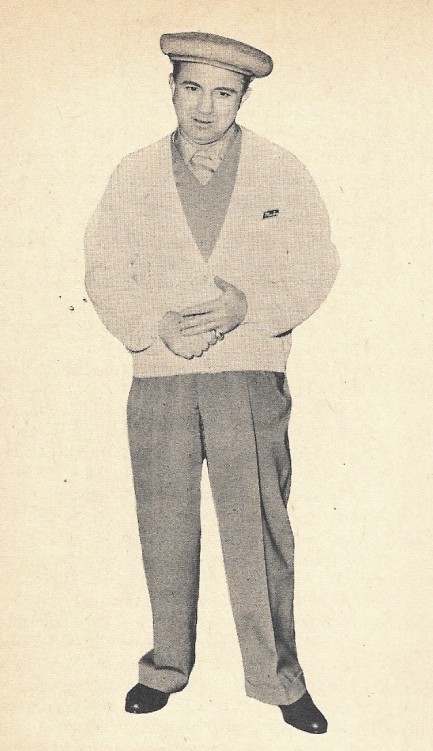
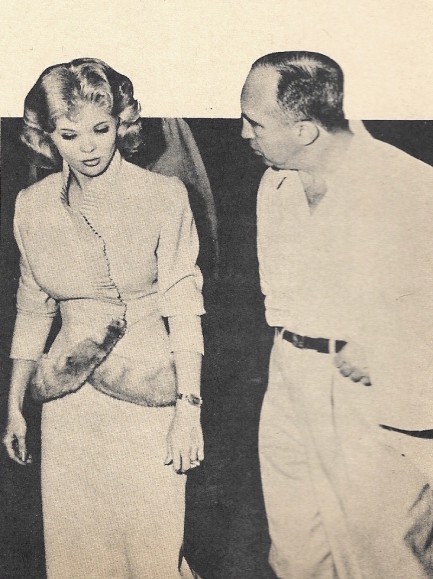
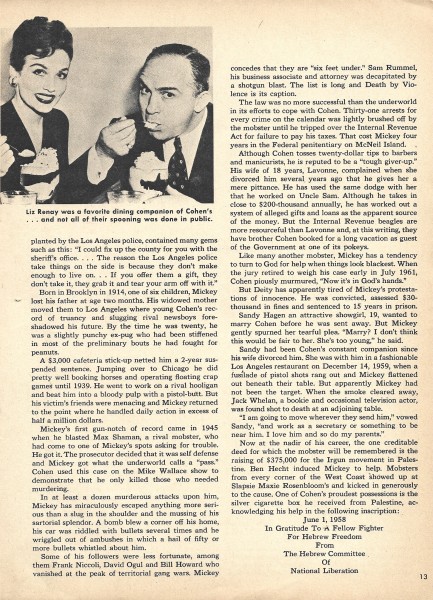
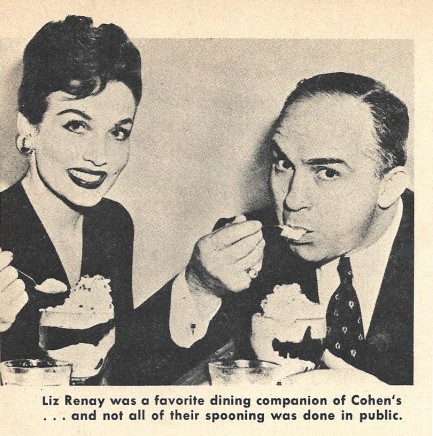
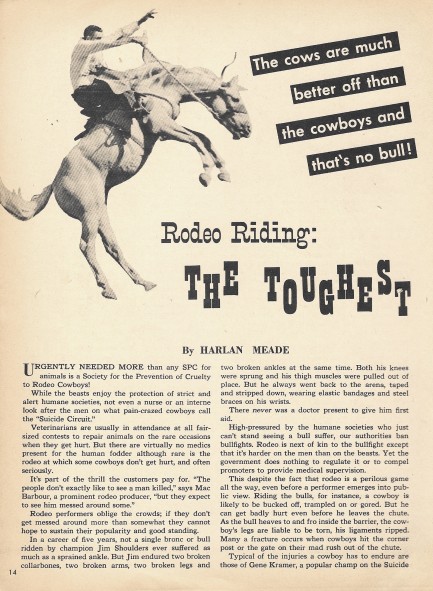
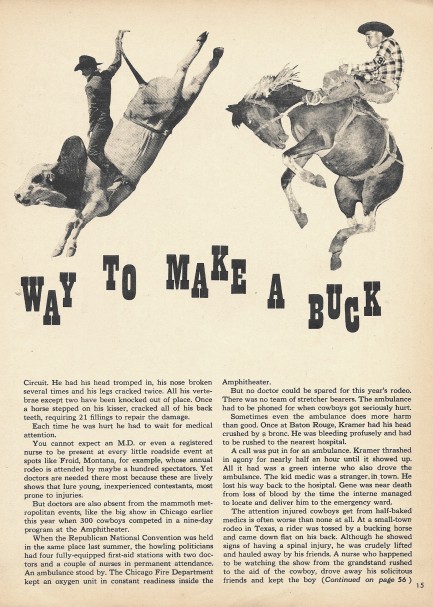
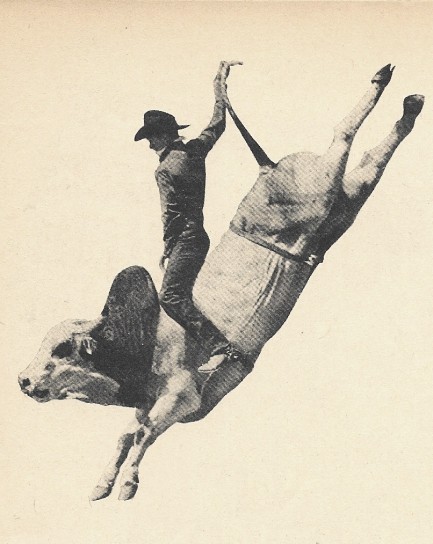
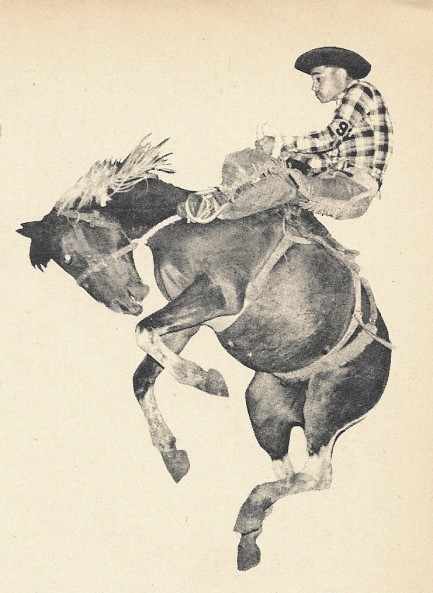
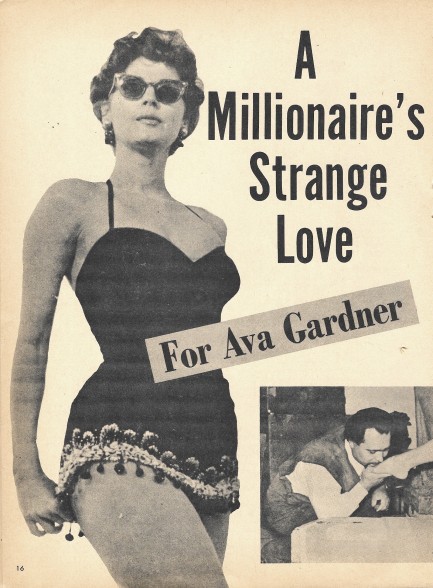
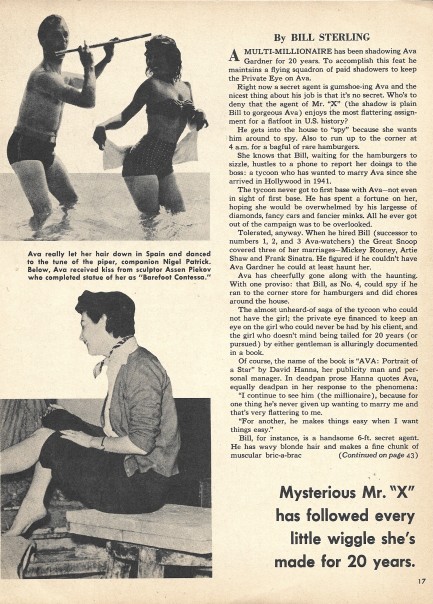
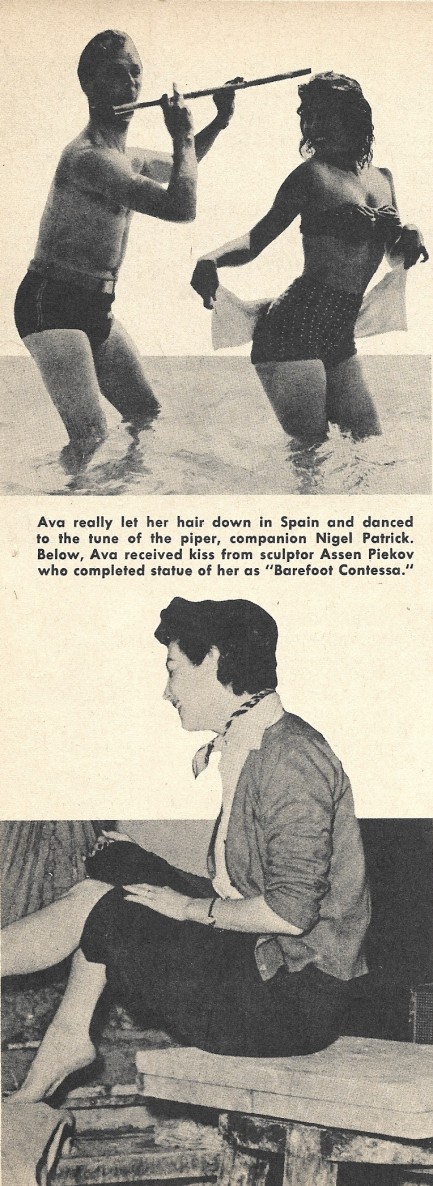
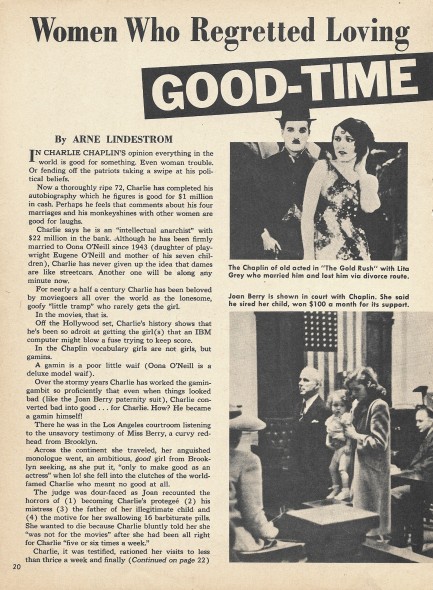
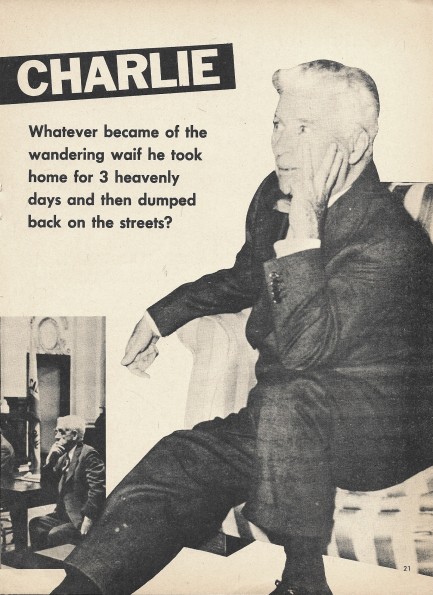
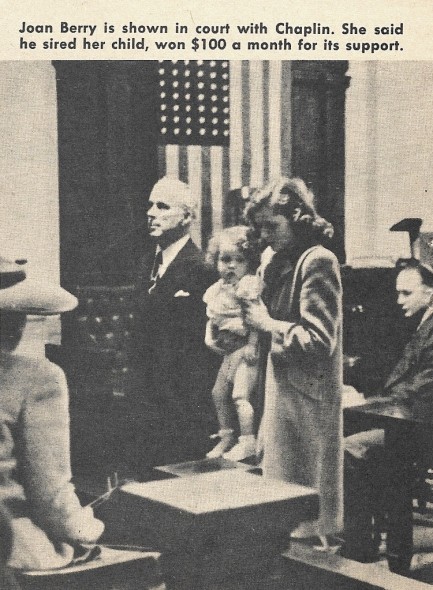
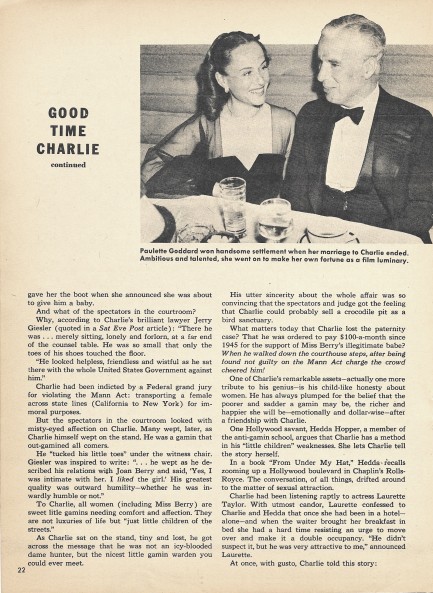
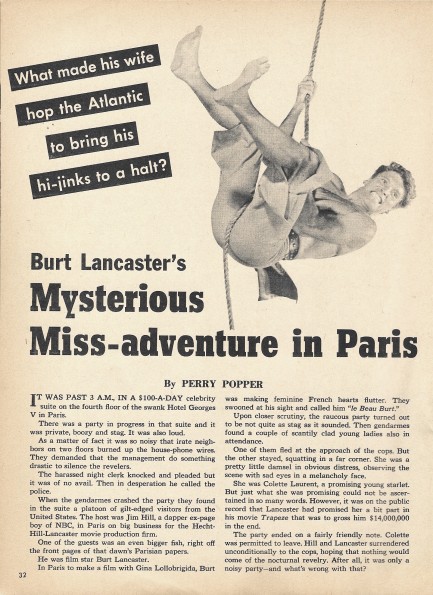
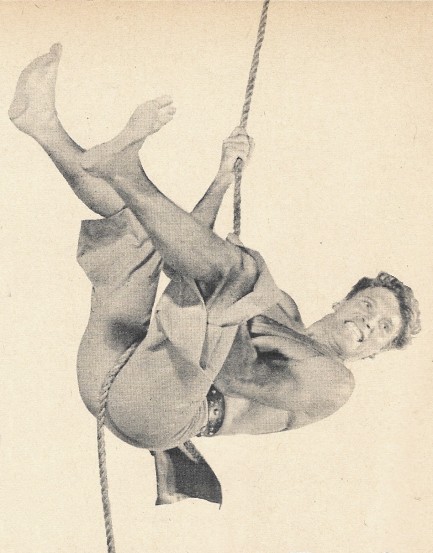
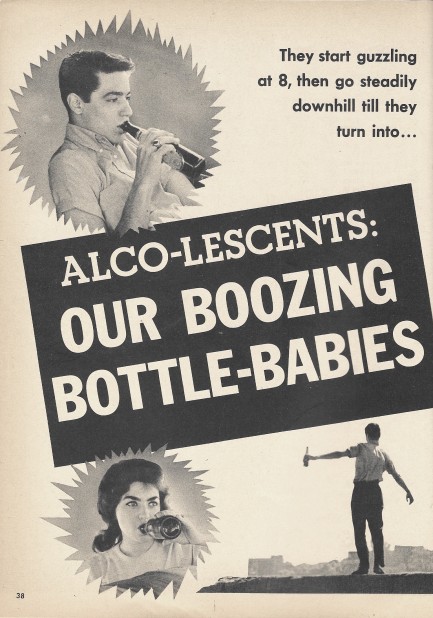
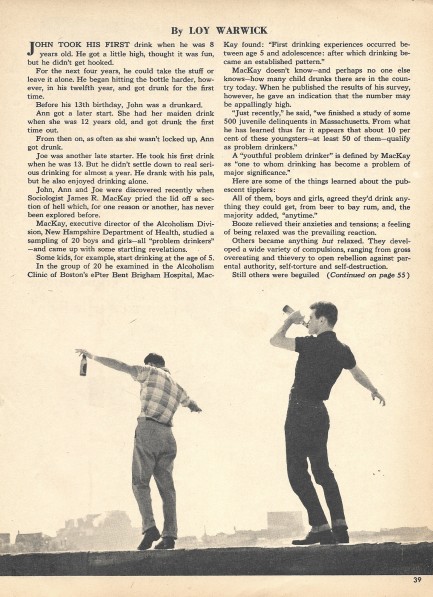
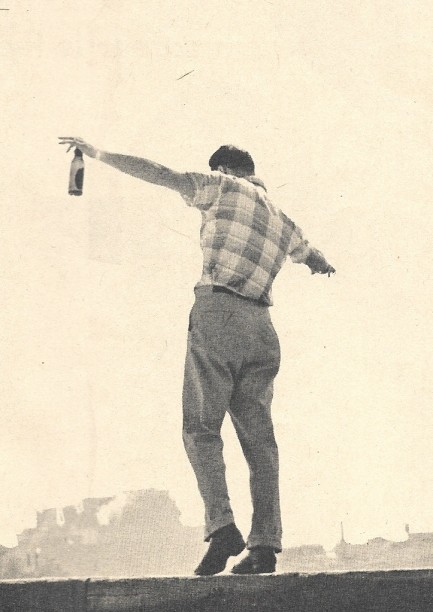
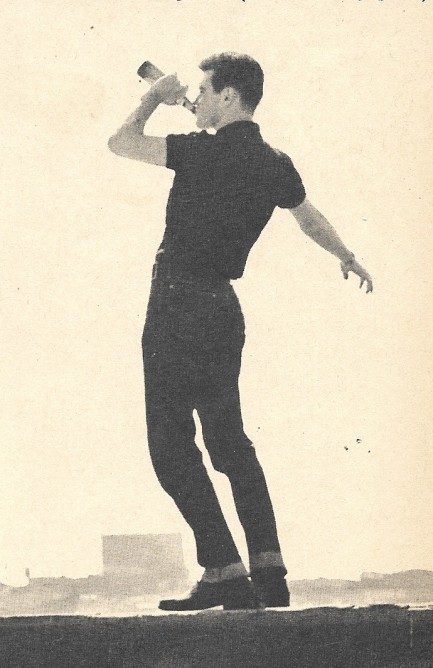
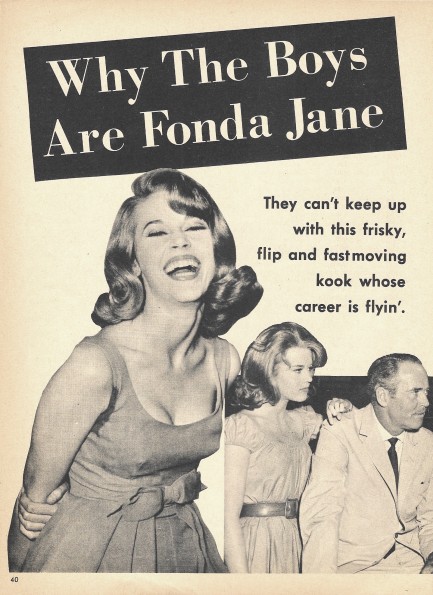
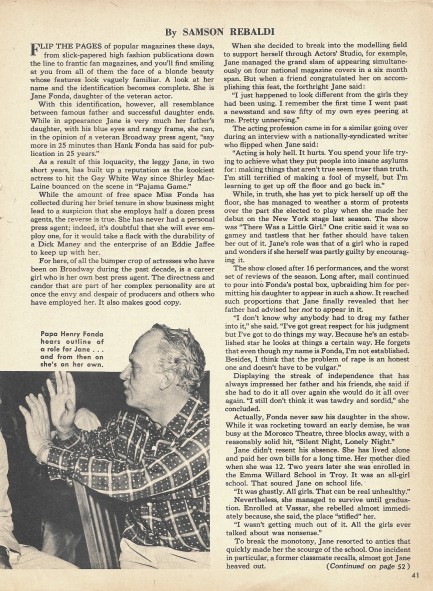
| The Naked City | Aug 28 2021 |

Two mafia pals split the bill.
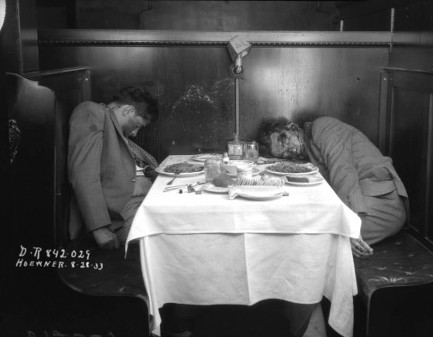
In our continuing focus on Los Angeles crime scene photos, above you see a shot of a mob hit on two unidentified gangsters who met their end over spaghetti dinners in an Italian restaurant booth. The worst part? They barely even got started on their meals and didn't get a chance to touch the crackers at all. That was today in 1933. Most of the crime scene photos we have are within our Naked City category, which you can access by clicking those words in yellow just above the title of this post.
| Vintage Pulp | Apr 14 2021 |

Humphrey Bogart meets an immoveable object.
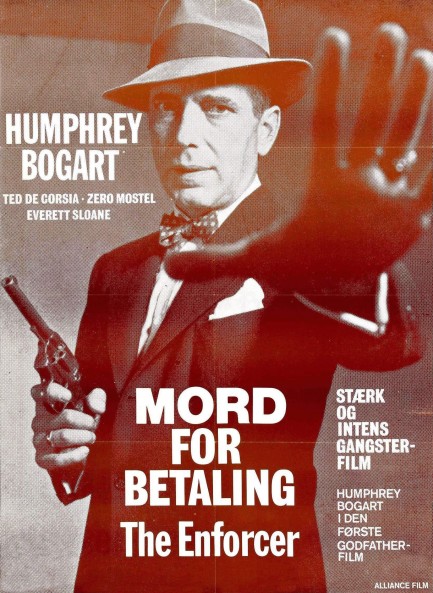
If you haven't seen Mord for betaling, better known as The Enforcer, you may want to add it to your queue. In addition to featuring yet another excellent Humphrey Bogart performance, it's a historical curiosity. Central to its plot is Murder, Inc., a group of killers-for-hire used by organized crime gangs. Murder, Inc. contracted anonymous killers for mob hits, leaving police with bodies but no motives and no suspects. In fact, the terms “contract” and “hit” were invented by Murder, Inc. The Enforcer is also of historical significance because showings featured a foreword in which Senator Estes Kefauver, chairman of the U.S. Senate Committee to Investigate Organized Crime, talked to the audience about the mafia, which the general public was just learning about at the time.
In the film Bogart plays a prosecutor who has been trying for years to bring down a crime boss named Albert Mendoza. When a witness dies, Bogart becomes aware of the existence of Murder, Inc. (though they aren't named that in the film), which to him seems like an impossibly bizarre idea. But he keeps uncovering more traces of the group until he finally believes. The rest of the film deals with his efforts to convince (or coerce) one of the cartel's members into being a witness in order to fry Mendoza. There are some twists and turns that force Bogart to shift gears more than once, and all of this is told in flashback, after the death of his stool pigeon, which happens in the first reel to set up the plot.
As we said, Bogart is solid as always, and he's helped greatly by Zero Mostel, who's quite good as a shaky potential witness. As far as the film as a whole goes, most vintage cinema fans consider it middling Bogart, but that's plenty good enough to warrant a look. The poster you see above, which we absolutely love, was made for Denmark, where the movie's title means, appropriately, “murder for payment.” We have several other posters for the film you can see at this link, and a cool Bogart promo photo that mirrors the above image, viewable at this link. The Enforcer premiered in the U.S. in 1951 and opened in Denmark today in 1952.
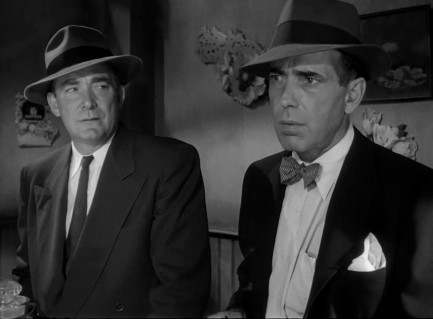 But I distinctly remember being told this was a bow tie-only affair.
But I distinctly remember being told this was a bow tie-only affair. I guess not.
I guess not.| Intl. Notebook | Oct 12 2020 |

Whether by day or night the action was non-stop.
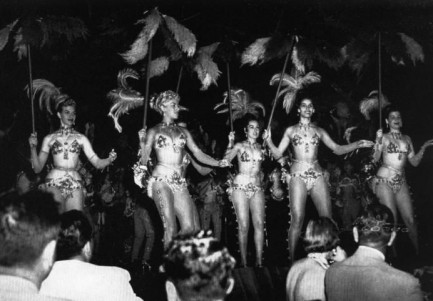
We love vintage nightclub photos, and vintage pix of people partying in general. Since Havana photos are unusually interesting, we're always drawn to them. There's a large number of Havana photos out there, but not primarily because of Cuba's political history. The photos really exist because Cuba was a pioneer of Caribbean tourism, attracting travelers beginning in the 1920s through a heyday of the mid-1950s. The island was promoted as a place of sophistication, mixed with permissiveness, unpredictability, and a touch of the primitive. This prompted various movers and shakers—from New York City businessmen to top musicians to Hollywood stars—to flock to Havana. And where important people went, cameras followed.
Was the Havana image true? Probably, based on what we've read. But it was not unique. During the same period Tangier had a similar reputation, as it attracted writers like Paul Bowles, William S. Burroughs, and numerous gay expatriates. During the 1960s Acapulco was known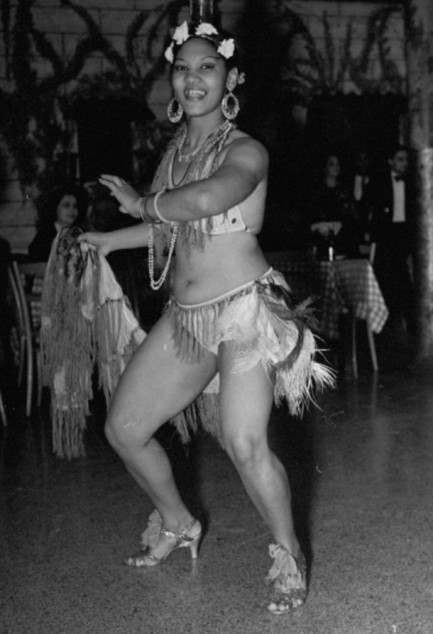 as a great place to go for thrills. During the 1980s, Ibiza or Mykonos. The 90s, Thailand or Goa. The 00s, Tulum. Havana wasn't unusual in terms of what it offered. Bigger, yes. More convenient for Americans, for sure. But numerous far flung locales have served as paradises for foreign visitors to lose themselves and get crazy.
as a great place to go for thrills. During the 1980s, Ibiza or Mykonos. The 90s, Thailand or Goa. The 00s, Tulum. Havana wasn't unusual in terms of what it offered. Bigger, yes. More convenient for Americans, for sure. But numerous far flung locales have served as paradises for foreign visitors to lose themselves and get crazy.
 as a great place to go for thrills. During the 1980s, Ibiza or Mykonos. The 90s, Thailand or Goa. The 00s, Tulum. Havana wasn't unusual in terms of what it offered. Bigger, yes. More convenient for Americans, for sure. But numerous far flung locales have served as paradises for foreign visitors to lose themselves and get crazy.
as a great place to go for thrills. During the 1980s, Ibiza or Mykonos. The 90s, Thailand or Goa. The 00s, Tulum. Havana wasn't unusual in terms of what it offered. Bigger, yes. More convenient for Americans, for sure. But numerous far flung locales have served as paradises for foreign visitors to lose themselves and get crazy.Most or all of the aforementioned places are considered to have changed for the worse, whether through ecological damage, destruction of historic architecture, unchecked overbuilding, overtourism, or all four scourges at once. But it was revolution that changed Havana, a fact that gives vintage photos from there a particular poignancy. A typical narrative is that while elites and tourists partied, exclusion, inequality, and poverty helped fertilize the seeds of upheaval. But we don't judge anyone in these shots. We've lived in similar circumstances in Central America. We were even partners in a beach bar in the Caribbean. We were always well aware of the prevailing socio-political problems, and we sympathized greatly with the local populations. But it didn't stop us from partying the nights away.
There's an immense feeling of freedom being in a simpler place—and for all its opulent nightclubs and restaurants, Havana is said to have exuded a primeval sensuality that intoxicated tourists and expatriates. If you live in the U.S. or some other modern nation, that feeling isn't something you can achieve by merely paring down your current lifestyle. The things you give up continue to exist all around you. By rejecting those, you become a weirdo. But by living in a less modern nation your life truly changes top to bottom, and you gain this while still existing above the local mean. That's the paradox, or the injustice, depending on your point of view: your satisfaction derives partly from the ability to take or leave anything you wish, because you are economically able to do so. You live more simply than you did, yet live better than most people around you. It isn't noble, but it's very much an attraction.
Bowles and Burroughs lived well in Tangier because it was immensely cheaper than Europe or the U.S. With the savings gained they hosted parties and had time to hone their literary crafts. They were a part of the local society, but existed in a middle-upper stratum, high above the impoverished, well below the Moroccan elites, benefitting from the general perception that foreigners from rich nations are themselves rich. That's how it was for us too. So there's inequality built into that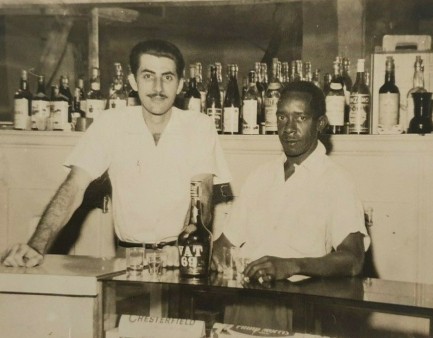 type of expatriate experience. It's unavoidable. A friend of ours lived in a stick shack on Cayos Cochinos for an entire year and he was still considered a rich foreigner. Everyone knows you have a choice. The Americans who partied in Cuba could never have been anything but wealthy invaders, no matter the reality of their finances, or the inclusiveness their sensibilities.
type of expatriate experience. It's unavoidable. A friend of ours lived in a stick shack on Cayos Cochinos for an entire year and he was still considered a rich foreigner. Everyone knows you have a choice. The Americans who partied in Cuba could never have been anything but wealthy invaders, no matter the reality of their finances, or the inclusiveness their sensibilities.
 type of expatriate experience. It's unavoidable. A friend of ours lived in a stick shack on Cayos Cochinos for an entire year and he was still considered a rich foreigner. Everyone knows you have a choice. The Americans who partied in Cuba could never have been anything but wealthy invaders, no matter the reality of their finances, or the inclusiveness their sensibilities.
type of expatriate experience. It's unavoidable. A friend of ours lived in a stick shack on Cayos Cochinos for an entire year and he was still considered a rich foreigner. Everyone knows you have a choice. The Americans who partied in Cuba could never have been anything but wealthy invaders, no matter the reality of their finances, or the inclusiveness their sensibilities.Living comfortably means the novelties one experiences seem thrilling or romantic. When we were knocking around Guatemala, El Salvador, and the Bay Islands, we turned washing our clothes by hand into an enjoyable ritual, yet understood quite well that many families' daily water intake literally depended on walking a mile to a river. Buying food from the local fruit and veggie stand was far more convenient than queuing at the supermarket for meat, and we ended up dropping to our college weight, but we were nevertheless aware that many people couldn't afford any food, and would have been disgusted at how pleased we were that our reduced fat intake meant we could show six pack abs at the beach. We helped some local families, both financially and logistically, but when your downsized existence is a choice you can never truly fit in.
But the freedom you feel is real. Offloading the burdens of modern life brings legitimate satisfaction. The pursuit of pleasure takes on a special joy. We hit bars, parties, and gallery mixers continually. As foreigners there's no social stigma to drinking every night. Unless you have a job—and we didn't—it's how you form a social circle. Locals generally disapprove, but their judgements carry little weight. So when we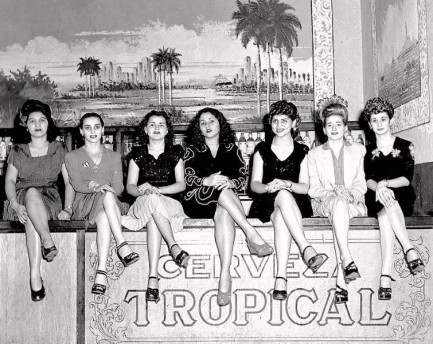 look at Havana partying shots we don't quite see oblivious, entitled people, because we know it isn't that simple. Most of them knew what was percolating. Stability was diminishing fast. There was a dissolved parliament, large protests, a 1953 battle in Santiago de Cuba, and other signposts on the way to change. It was clear the fun could never last.
look at Havana partying shots we don't quite see oblivious, entitled people, because we know it isn't that simple. Most of them knew what was percolating. Stability was diminishing fast. There was a dissolved parliament, large protests, a 1953 battle in Santiago de Cuba, and other signposts on the way to change. It was clear the fun could never last.
 look at Havana partying shots we don't quite see oblivious, entitled people, because we know it isn't that simple. Most of them knew what was percolating. Stability was diminishing fast. There was a dissolved parliament, large protests, a 1953 battle in Santiago de Cuba, and other signposts on the way to change. It was clear the fun could never last.
look at Havana partying shots we don't quite see oblivious, entitled people, because we know it isn't that simple. Most of them knew what was percolating. Stability was diminishing fast. There was a dissolved parliament, large protests, a 1953 battle in Santiago de Cuba, and other signposts on the way to change. It was clear the fun could never last.The assortment of people you see here are caught on film like insects caught in amber, long dead but preserved. They're having a few laughs, enjoying some drinks, executing deft turns on dance floors, making their small, temporary marks on the world, leaving behind images showing them for one sliver of a moment in timeless eternity. Things changed in Havana, and now things have changed for all of us. If circumstances where we can dance and laugh and shout together in hot crowded places without fear of sickness ever return, be sure to embrace them fully. We don't just mean in some far flung tropical enclave. We mean anywhere. Because if it isn't a virus that takes those pleasures away, it'll be the march of years. You'll want to have done your best with this gift called life.
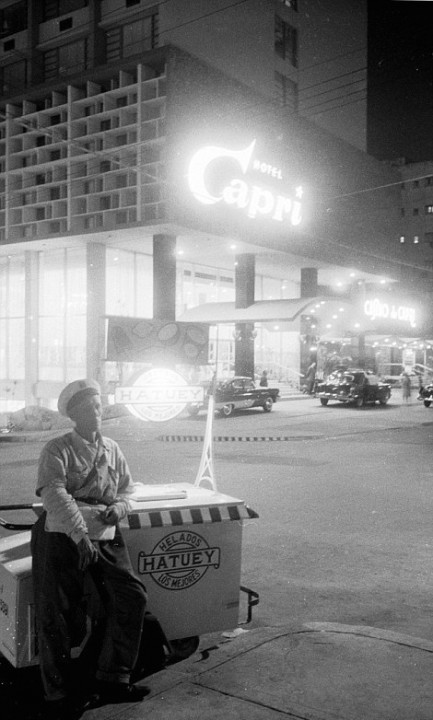 An ice cream vendor patiently waits for potential customers to emerge from the Capri Hotel and Casino, 1958.
An ice cream vendor patiently waits for potential customers to emerge from the Capri Hotel and Casino, 1958.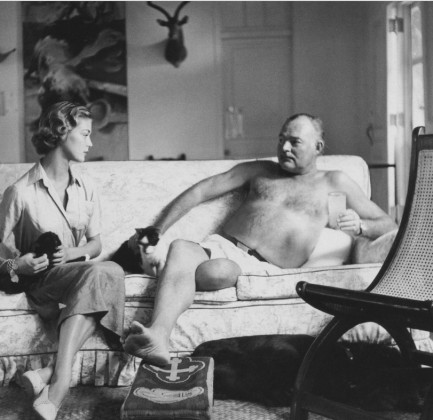 Fashion model Jean Patchett and author Ernest Hemingway, who habitually went shirtless, lounge at Finca Vigia, his house in Cuba, 1950.
Fashion model Jean Patchett and author Ernest Hemingway, who habitually went shirtless, lounge at Finca Vigia, his house in Cuba, 1950.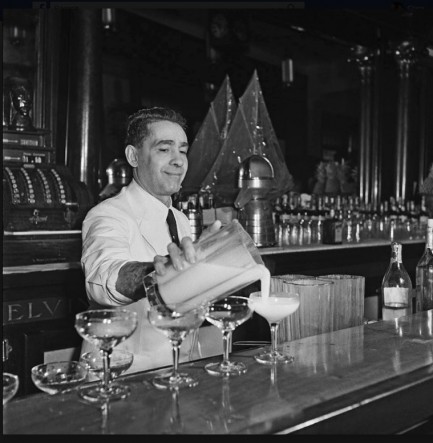 Above, Constantino Ribalaigua Vert, the "Cocktail King of Havana," inventor of the Papa Doble daiquiri, and owner of the famed bar La Floridita.
Above, Constantino Ribalaigua Vert, the "Cocktail King of Havana," inventor of the Papa Doble daiquiri, and owner of the famed bar La Floridita.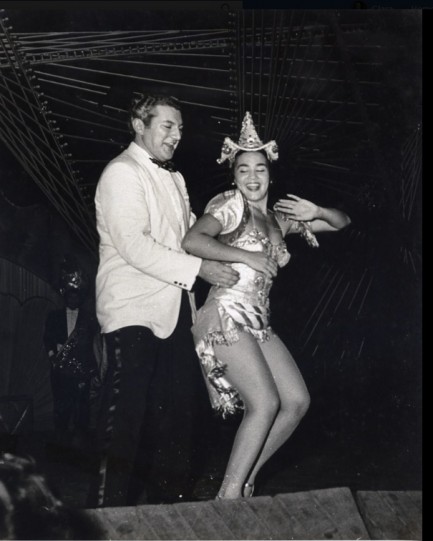
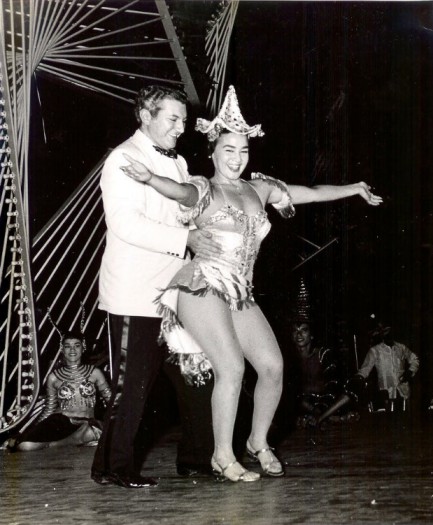 Liberace performs on stage at the Tropicana with headline dancer Ana Gloria Varona, 1954.
Liberace performs on stage at the Tropicana with headline dancer Ana Gloria Varona, 1954.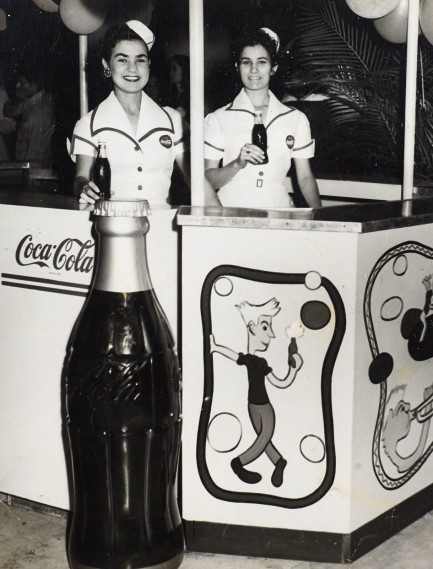 A Coke and a smile from two soft drink vendors.
A Coke and a smile from two soft drink vendors.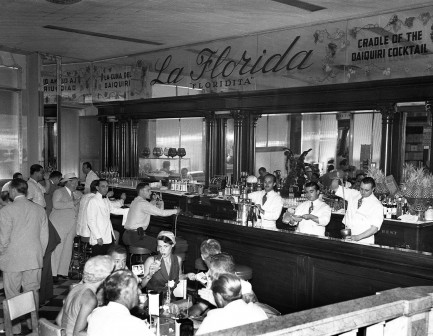 Patrons enjoy drinks at La Floridita, 1955.
Patrons enjoy drinks at La Floridita, 1955.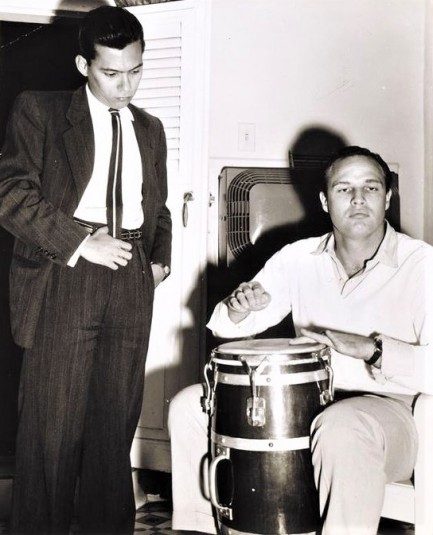 Cuban writer Guillermo Cabrera Infante stands by while Marlon Brando tries his hand—or both of them—at the conga drum at Hotel Packard, 1956.
Cuban writer Guillermo Cabrera Infante stands by while Marlon Brando tries his hand—or both of them—at the conga drum at Hotel Packard, 1956.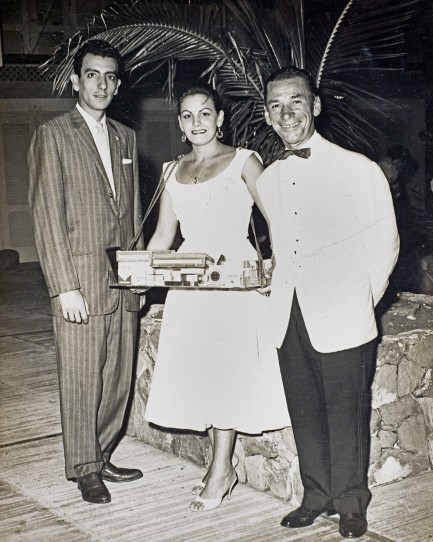 Mafia kingpin Meyer Lansky, on the right in this shot, attends the opening of the Hotel Riviera in December 1957.
Mafia kingpin Meyer Lansky, on the right in this shot, attends the opening of the Hotel Riviera in December 1957.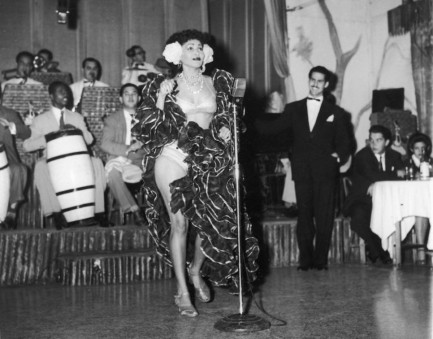 Famed entertainer Zulema dances the rhumba at the Zombie Club, 1946.
Famed entertainer Zulema dances the rhumba at the Zombie Club, 1946.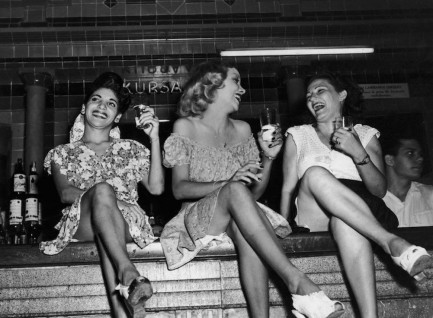 Three women liven up the room from their perch on the bar at Cabaret Kursal.
Three women liven up the room from their perch on the bar at Cabaret Kursal.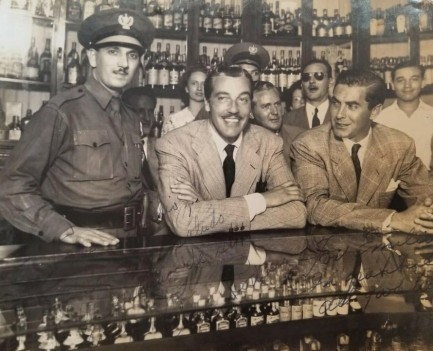 Cesar Romero and Tyrone Power enjoy a drink and a chat at Sloppy Joe's Bar.
Cesar Romero and Tyrone Power enjoy a drink and a chat at Sloppy Joe's Bar.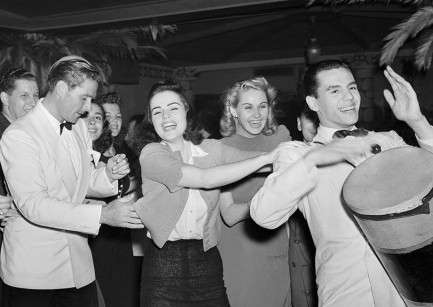 Revelers including Errol Flynn and Desi Arnaz, Jr. form a conga line during the Yoruba festival known as Dia de Babalú-Ayé.
Revelers including Errol Flynn and Desi Arnaz, Jr. form a conga line during the Yoruba festival known as Dia de Babalú-Ayé.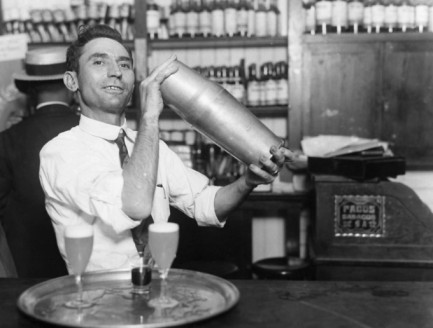 José Abeal Otero, founder of Sloppy Joe's Bar, mixes up a giant batch of liquid magic. No, this isn't the same person as above, Ribalaigua. They were both small, dapper guys.
José Abeal Otero, founder of Sloppy Joe's Bar, mixes up a giant batch of liquid magic. No, this isn't the same person as above, Ribalaigua. They were both small, dapper guys.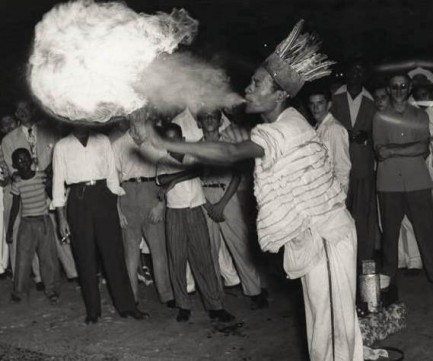 A firebreather thrills onlookers in front of the Saratoga Hotel, 1949.
A firebreather thrills onlookers in front of the Saratoga Hotel, 1949.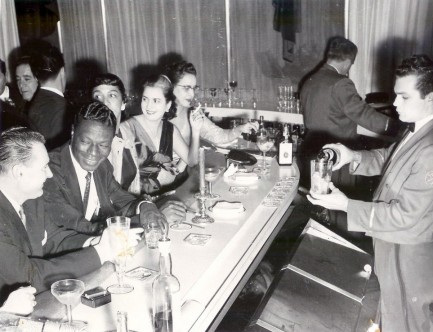 This photo shows Nat King Cole and his wife Maria Cole, along with Martin Fox, who was the owner of the Tropicana, accompanied by his wife Ofelia and an unknown fifth party.
This photo shows Nat King Cole and his wife Maria Cole, along with Martin Fox, who was the owner of the Tropicana, accompanied by his wife Ofelia and an unknown fifth party.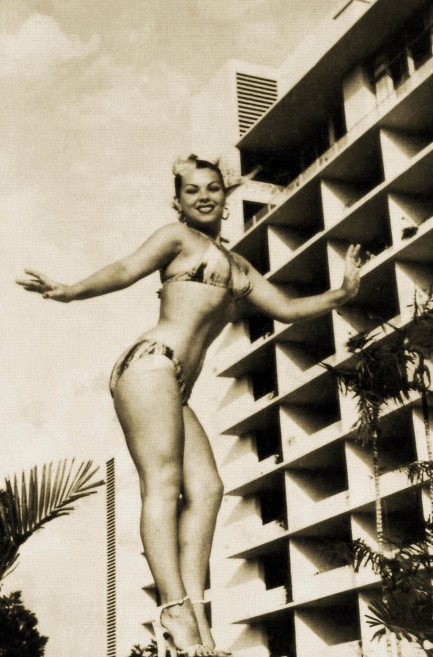 U.S. born vedette and movie star Tongolele, aka Yolanda Montes, poses outside the Capri Hotel and Casino, 1958.
U.S. born vedette and movie star Tongolele, aka Yolanda Montes, poses outside the Capri Hotel and Casino, 1958.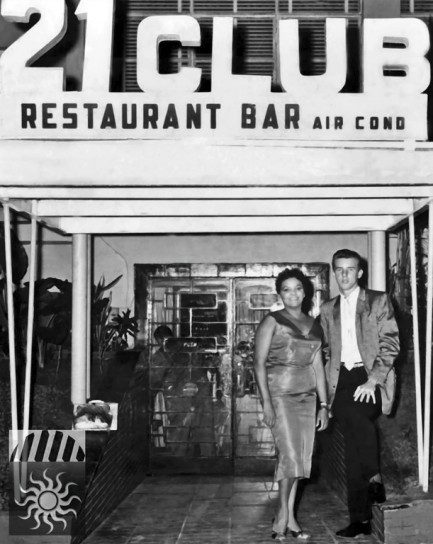 Meme Solis and Elena Burke pose at the entrance to the 21 Club, located in the Capri Hotel.
Meme Solis and Elena Burke pose at the entrance to the 21 Club, located in the Capri Hotel.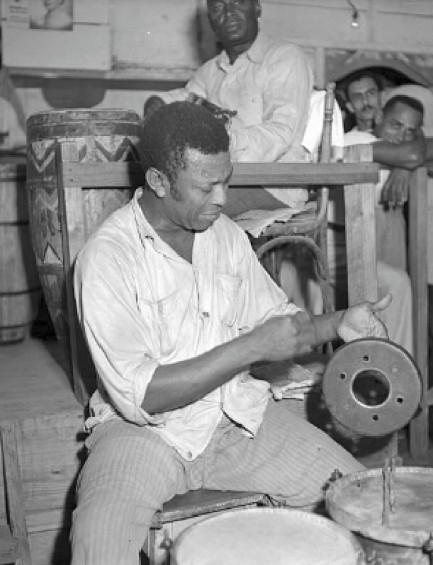
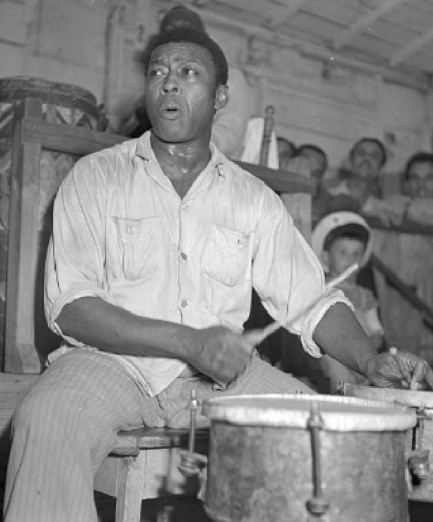 These photos show Silvano Chueg Echevarría, a master of percussion and an iconic musical personage. Let's go back to that Marlon Brando photo for a sec. Brando was an aficionado of percussive instruments. During that 1956 jaunt to Cuba he made it known that he wanted to buy drums from real percussionists. One of the musicians he met was Echevarría. All the Havana percussionists knew of Brando, of course, but thought he was a musical dilettante. At some point he finagled his way onto a nightclub stage, sat in with a band, and truly amazed onlookers with his ability on the conga. He wasn't a master, but he was pretty good. He won respect, and bought his drums.
These photos show Silvano Chueg Echevarría, a master of percussion and an iconic musical personage. Let's go back to that Marlon Brando photo for a sec. Brando was an aficionado of percussive instruments. During that 1956 jaunt to Cuba he made it known that he wanted to buy drums from real percussionists. One of the musicians he met was Echevarría. All the Havana percussionists knew of Brando, of course, but thought he was a musical dilettante. At some point he finagled his way onto a nightclub stage, sat in with a band, and truly amazed onlookers with his ability on the conga. He wasn't a master, but he was pretty good. He won respect, and bought his drums.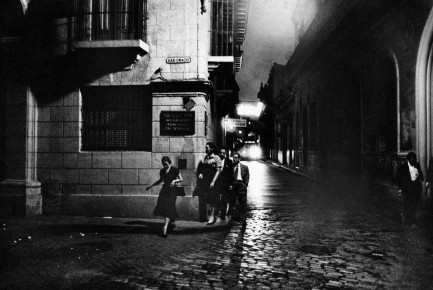 Raquel Revuelta, Manuel Corrales, and Mariano Rodriguez leave the famed bar Bodeguita del Medio and walk through the Havana night to other locales, other adventures, 1958.
Raquel Revuelta, Manuel Corrales, and Mariano Rodriguez leave the famed bar Bodeguita del Medio and walk through the Havana night to other locales, other adventures, 1958.CubaHavanaTropicanaErnest HemingwayJean PatchettLiberaceNat King ColeMaria ColeOfelia FoxMartin FoxTongoleleYolanda MontesAna Gloria VaronaMarlon BrandoGuillermo Cabrera InfanteCesar RomeroTyrone PowerMeyer LanskyRaquel RevueltaManuel CorralesMariano RodriguezJosé Abeal OteroConstantno Ribalaigua VertSilvano Chueg EchevarríaErrol FlynnDesi Arnaz Jr.mafia
 |
 |




































































